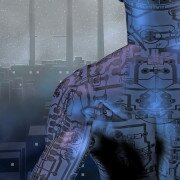The Future We Deserve
TDW: Dystopias are everywhere. The Hunger Games and Divergent, as well as countless other gloomy books and films, reflect our fascination with totalitarian and fascist regimes where the general populace are nothing more than pawns of the privileged. The is a reflection of the times as inequality rises, environmental degradation continues unabated, and the surveillance state closes in. But that isn’t why we have this fascination with dystopias. No, a dystopia implies we can escape from whatever malaise effects our current culture. As Gerry Canavan describes it:
Dystopia is about oppressive social conditions that might be altered, evaded, or averted, and so it still contains hidden within itself the same hope for a better world that drives utopian speculation.
Most people would define a dystopia as the bad version of a utopia (dystopia literally means ‘bad place’), the negation to quote Gerry. Interestingly utopia means ‘not a place’, which isn’t as hopeful as you would think – it is a place so fanciful that it cannot possibly exist. When we see a dystopic future it paints the same picture, which is that things could be better than they are (one fanciful, one an escape fantasy). But these two futures don’t go far enough. What we really need today is to delve into – now that the world appears to be coming to an inevitable end – the anti-utopia, or the place from which we cannot escape. Literature that focuses on this aspect would be more confronting.
Using Gerry’s definitions, there are two other possibilities to the typical utopia and dystopia. The first is the idtopia, which I propose as it carries the idea of the unconscious self – in other words, human nature. An idtopia is the anti-utopia, so that while we think we can achieve perfect balance, our own primal instincts will lead to problems forever (usually involving violence). Utopia can never be achieved because we are quite simply awful. Following from that there is the anti-dystopia and the negation of the anti-utopia: a praetopia. This world is merely déjà vu; it is what has come before. The worst of all possibilities to imagine is that this is the best we can achieve, that our current neoliberal tendancies allow for nothing more. We have reached our peak; why bother striving for better?
Dystopian fascination has almost come full circle. With the film release of The Giver – arguably the kickstarter for the present dystopian YA fascination – coming to cinemas soon, it seems that territory has well and truly run its course. So what next? What should literary trendsetters portray now that dystopias will soon peter out and have had little effect beyond titillation? Enter the id- and praetopia.
A good example of the latter is Snowpiercer. The movie is set on a globe-trotting train on which the last of humanity survives after a neoliberal attempt at solving global warming goes horribly wrong. The main character leads a revolution to free his people from the back of the train and wrest control from the powerful overlords. Spoiler: When he gets there he finds out that it has happened before and that it is all part of the plan. Indeed, the current ruler wants to handover to the revolutionary who will have no choice but to continue in his stead. The only other option is to make the whole cycle crash and burn. Certainly, this is not a hopeful ending.
This could be the beginning of a harrowing trend. There is no hope for our future selves, so what we need is the facts. There is no escape from the perpetual machine unless we take drastic action. We will be doomed to repeat mistakes, doomed to be satisfied with our lot, doomed to never try. But the exciting thing is that science fiction can always imagine escape routes, devious and ingenious plans to avoid The End. We need science fiction to show us our idtopias and praetopias. Then maybe after we can explore a spetopia (hopeful place).






